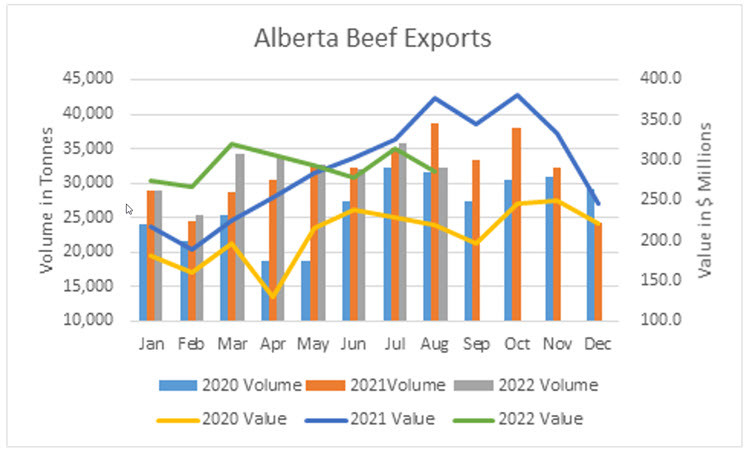Non-urgent government operations are closed December 24 to January 1, reopening January 2. View available services during this period.
See event listings and more articles in this edition of Agri-News: October 24, 2022 issue
“The week ending October 14, 2022 saw minimal buyer bidding on live fed steers in Alberta,” says Ann Boyda, provincial livestock market analyst with Agriculture and Irrigation. “A weekly price trend was not available. The prior week did see a modest increase of $.24/cwt on fed steers in comparison to Nebraska’s increase of $Cdn2.75/cwt. The price spread between the 2 markets was $20.59/cwt under.”
The 5-year average prices of these 2 price series shows a closer alignment. The spot basis (difference between the cash price and the nearby futures price) is estimated to be $18.50/cwt under. The same week in 2021 reported a spot basis of approximately $2/cwt over. Why the deviation? Is the Alberta cattle market out of sync with the U.S. market?
“There are a number of factors influencing recent cattle markets, starting with narrowing packer margins,” says Boyda. “Packer margins are closer to average versus the higher levels of the recent year. Demand is keeping throughput moving but last week there were insufficient bids to register a trend in fed steer prices. Listings are now into November.”
Tighter supplies in the U.S. are putting U.S. packers in the red. HedgersEdge.com reported beef packers losses of $US14.35/head on October 11, 2022, down from earnings of $US18.40/head the week before.
“The U.S. is keeping cattle processing current but this may not be the case in Alberta. Commercial red meat production for the U.S. totaled 4.83 billion pounds in August, up 5% from August 2021. Cattle slaughter totaled 3.08 million head, up 7% from August 2021.”
The average live weight was down 6 pounds from the previous year. U.S. packers are processing cattle at a greater pace than that of the last 2 years. In comparison, according to data from the Canadian Beef Grading Agency, Alberta steer carcass weights have increased to 953 pounds in September 2022, approximately 20 pounds higher than September 2021. Heavier weights and longer delivery schedules suggest that the Alberta processing is still not current.
“The weaker basis levels may encourage holding feeders longer; however rising costs of gain need to be considered. Barley prices have risen every week since the last week in August 2022, from $359.50 to $431.50/tonne based in Lethbridge.”
The pull for cattle is not as strong as earlier in the year, notes Boyda. Weekly slaughter for the West Region on the week of October 8, 2022 was 49,234 head, 8.9% lower than the same week in 2021, but equivalent in terms of year-to-date over 2021. The Canadian Beef Grading Agency reported the first quarter slaughter volume of 2022 as 5.5% higher than that of the same period in 2021. By the third quarter of 2022, slaughter volumes were 4.8% lower than the same quarter in 2021.
Finally, Alberta beef exports to key markets slipped in August 2022. Beef (fresh, frozen or chilled, including offal) export volume in August was 32.2 tonnes, 9.9% lower than the previous month and 16.8% lower than August 2021.
The value of beef exports in August 2022 was $286.1 million, a drop of 9.2% from July 2022 and a decrease of 24% over August 2021. 2022 started strong but the key markets of U.S. and Japan saw a decline in August. Although Canada remains the top beef supplier to the U.S., Brazil and Mexico have made inroads and U.S. beef imports increased by 8.6% over 2022.
Chart 1. Alberta beef exports

“Recession concerns are pervasive. The global economy may be in a worse position than Canada finds itself and that too has impacts. The U.S. cattle market is likely to see continued high prices as it continues into its liquidation phase of the cattle cycle. The drought in the U.S. and tight supplies will contribute to the price pressure. The strong U.S. dollar and strong demand ahead of the holiday season should provide some support to Alberta prices in the fourth quarter of 2022,” says Boyda.
For more information, see:
Contact
Connect with Ann Boyda for more information:
Phone: 780-422-4088
Sign up for Agri-News
Start every Monday with the week’s top agricultural stories and latest updates.
Read about all things agriculture at Alberta.ca/agri-news